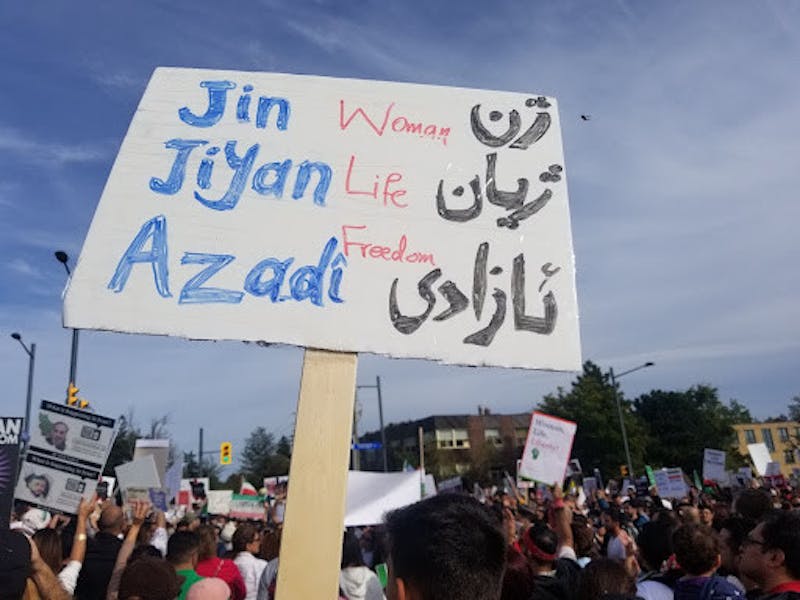
By Lilly Ward
Staff Writer
An Iranian artist living in exile in Turkey has revealed to Iran International that she was subjected to extreme torture of a physical and psychological nature while imprisoned in Karaj’s Kachoui prison.
Elham Modarresi, a 32-year-old artist of Kurdish descent (a minority group in Iran), was arrested in Nov. 2022 for her involvement within the Woman, Life, Freedom protests on charges such as vandalism of facilities, anti-government propaganda, disrupting public order and inciting people to kill.
On the day of her arrest, Modaressi wrote on X, then known as Twitter, “12 Iranian security agents stormed our house, violently pushed my mother, put handguns against my mother and brother’s heads, blindfolded me and took me away.”
While imprisoned, the artist was denied access to a lawyer and suffered from internal bleeding from brutal beatings while undergoing a hunger strike, according to a report by Hengaw Organization for Human Rights. Her health was threatened as she also suffered from liver and intestinal disease but was denied access to medical care. Currently, she is in need of a liver transplant.
“I was injected with substances that worsened my condition to the extent that I could barely breathe,” Modarresi said in a post on X. “This process continued until they were sure that I had cirrhosis of the liver.”
Modaressi was temporarily released on bail from Karaj’s Kachoui prison on Jan. 22, allowing her to escape to Turkey.
“I ask freedom seekers and those leading this movement for help and cooperation,” said Modarresi.
Modarresi is just one of many artists, writers and musicians who have been arrested for involvement in the protest movement. Earlier this year, 12 activists were arrested ahead of the anniversary of the protests in September, according to the Washington Post.
According to PEN America, a non-profit organization dedicated to protecting free speech, the regime targets writers and artists in particular. Well known figures in Iran, such as blogger and opinion writer Hossein Ronaghi, as well as popular musician Shervin Hajipour, who wrote the song “Baraye,” were arrested in 2022. A full list of those arrested in 2022 can be found on PEN’s website.
After the 1979 cultural revolution in Iran, in which the country rapidly transformed from a monarchy to a theocracy headed by a supreme religious leader known as the Ayatollah, the establishment of the Ministry of Culture and Islamic Guidance in 1981 has resulted in strict control over all media produced in Iran. Books, works of art and films that, in the view of the ministry, violate Iranian ethics or promote values alien to Iranian culture are either heavily censored or banned.
However, in the wake of the protests the government has placed even stricter regulations on internet access, orchestrating internet shutdowns across the country, as well as blocking Instagram and WhatsApp. The regime is now targeting virtual private networks, or apps that provide an encrypted connection to a remote server, which protects the user’s data, according to Reporters Without Borders
Although censorship of art is part of the reality of life for artists in Iran, many of whom are adept at employing ambiguous imagery to avoid censorship, the regime’s attempt to smother the spark of the protest movement has led to an elevated interest in silencing their voices. However, some artists are uninterested in backing down.
Despite the imminent threat of danger, the art created in response to the protests is bold and unflinching.
In the work of artist Meysam Azarzad, for example, an Iranian artist known for his bold graphic style, the work is expressive and daring, leaving no room for ambiguity. In one of his posters, the figure of a girl stands before an army, her fist raised as if in the middle of a rallying cry.
An inscription from the Shahnameh, a Persian Epic poem, reads, “This massive army is useless. Indeed, a single fighting girl is worth hundreds of thousands of them.”
The recent work of artists such as Azarzad represents a clear departure from the careful use of symbolism in art to avoid backlash. In the wake of the protest, artists are instead refusing to dilute the message behind their work, daring the regime to attempt to silence their voices.
This post was originally published on this site be sure to check out more of their content.






